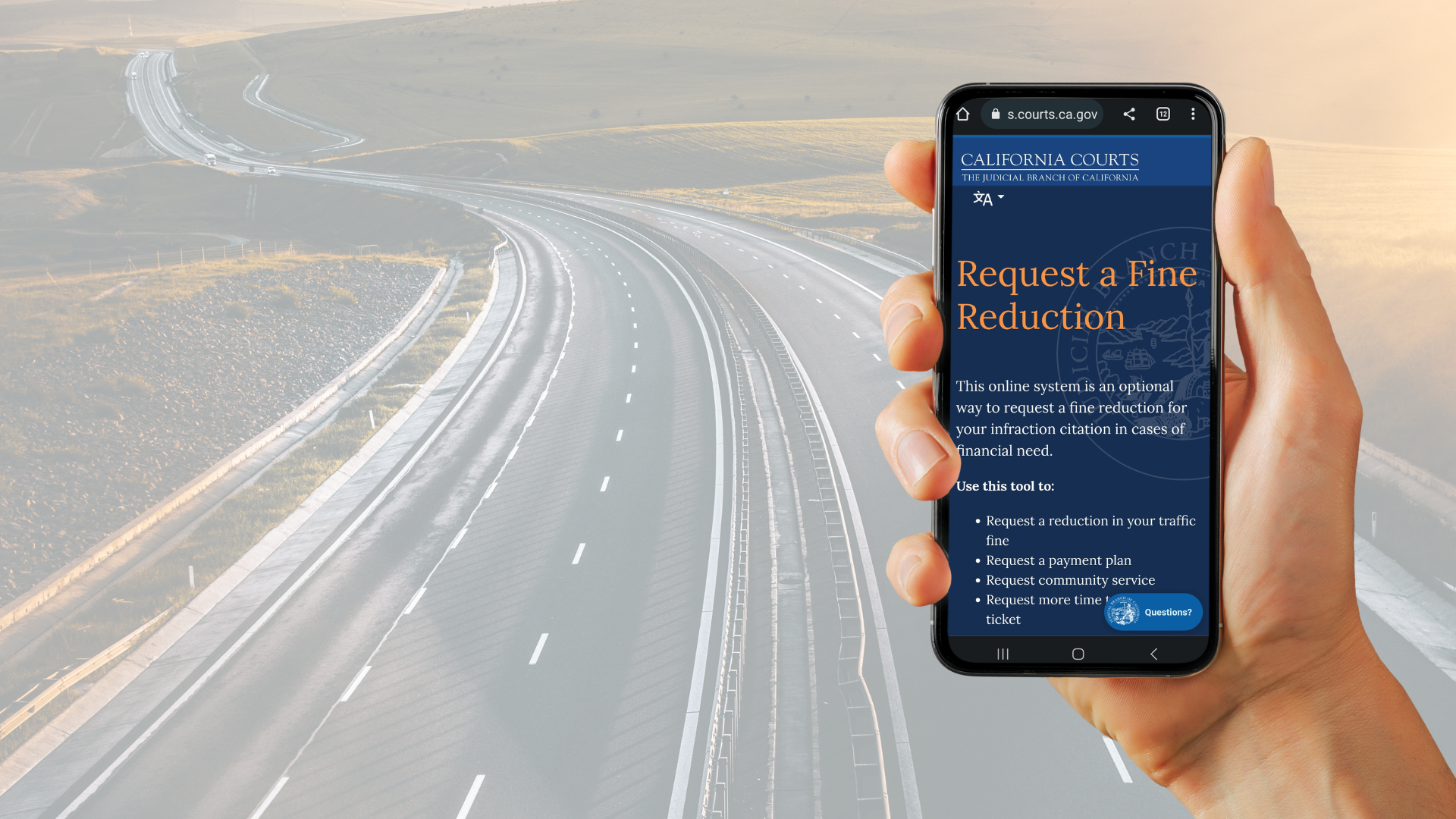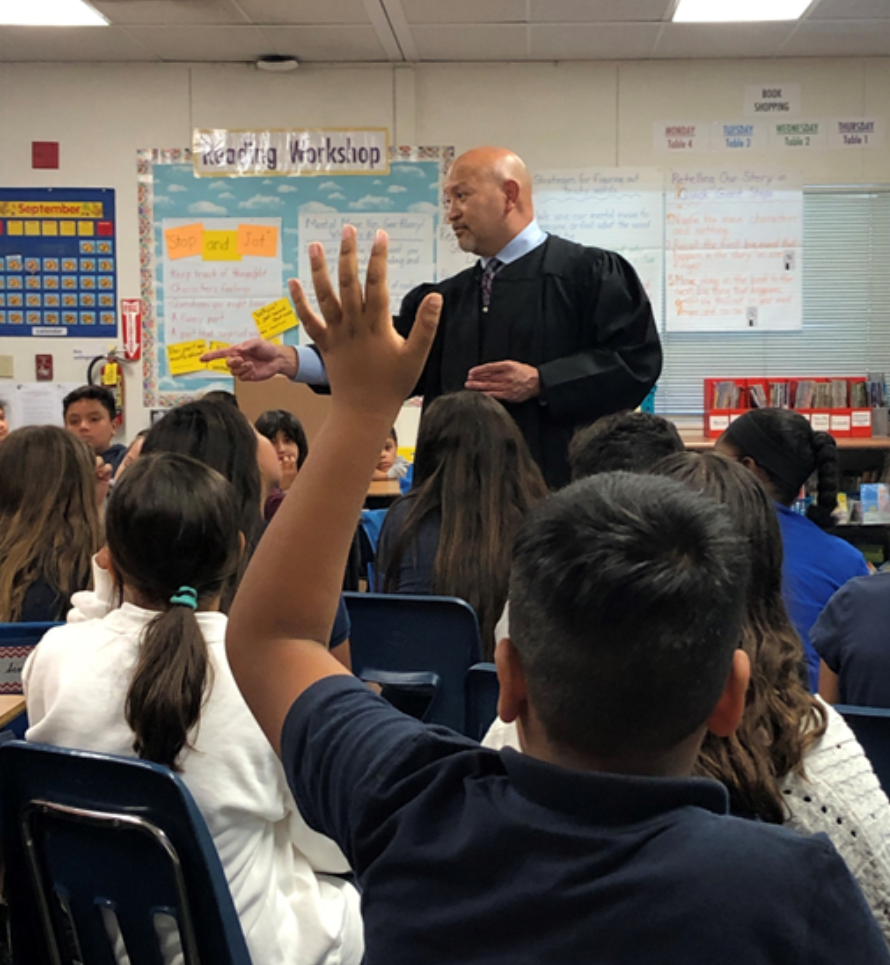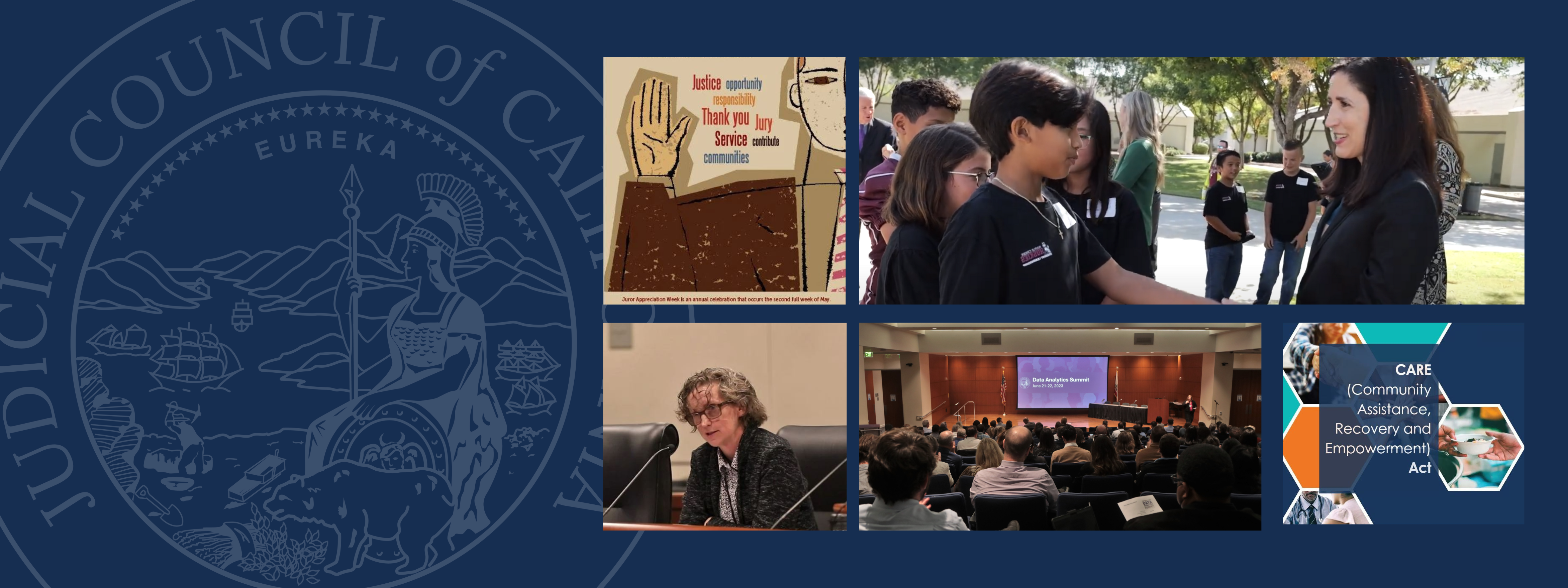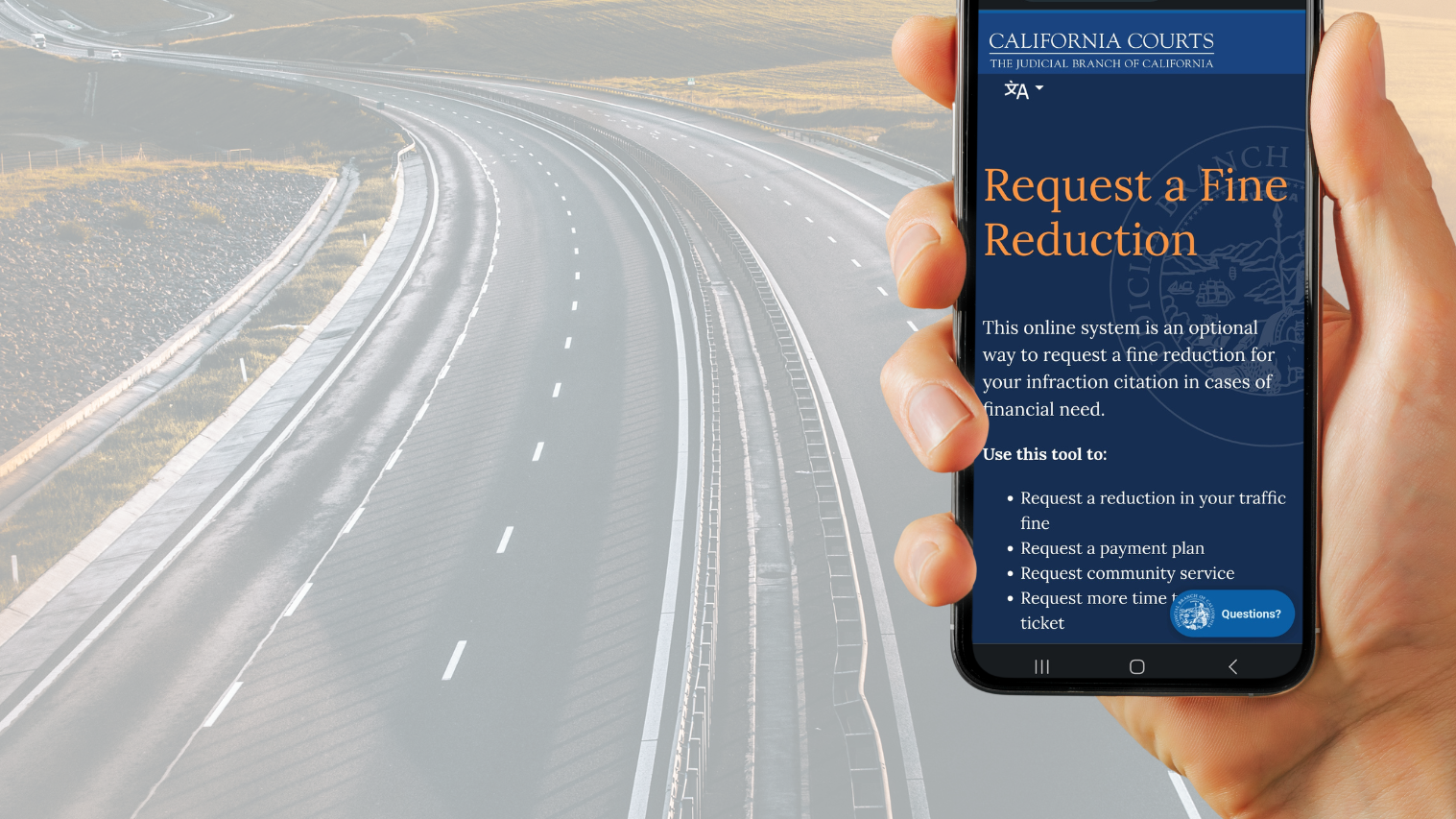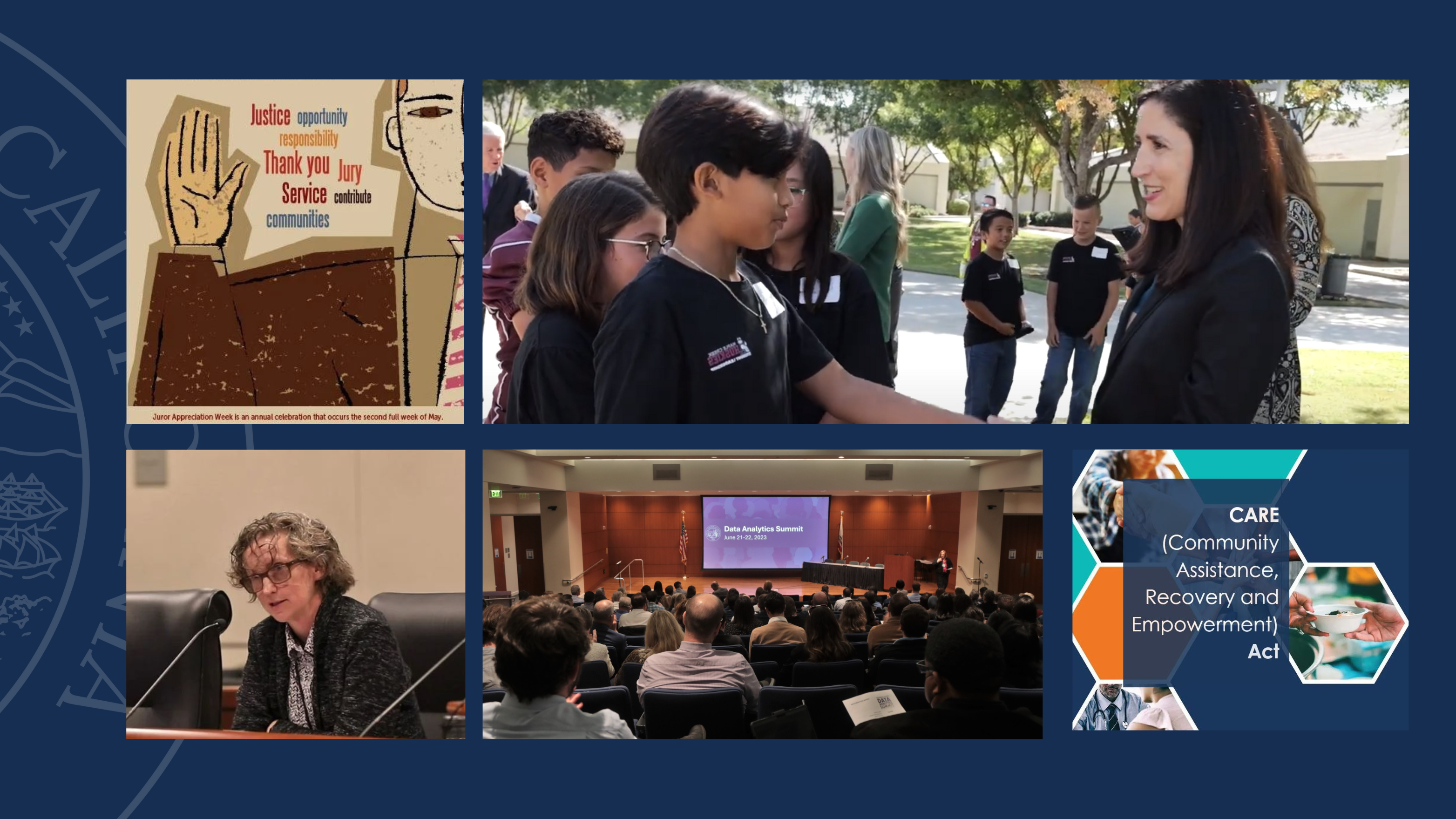
2023 Year in Review: Judicial Council of California
California’s new Chief Justice, the Judicial Council, and the courts continued to identify, refine, and enhance court operations and services to improve access to the justice system.
The following are highlights of those efforts:
New Chief Justice Prioritizes Access, Diversity, and Public Service
Chief Justice Patricia Guerrero was sworn into office on January 2, 2023, making history as the first Latina to serve as California’s Chief Justice. In her first State of the Judiciary address, and throughout her first year in office, Chief Justice Guerrero acknowledged her family’s sacrifices, the importance of her heritage, and her commitment to a more diverse and inclusive judicial branch.
The Chief Justice also placed a high priority on accountability, public service, and providing high-quality services to court users. To meet these goals, she’s advocated for stable and reliable funding, additional judgeships for under-resourced courts, and increasing the ability of court users to conduct business online through remote technology and procedures employed during the pandemic.
Sister Branches’ Continued Support for Judicial Branch
The fiscal year 2023-24 state budget included no cuts to court operational funding, which Chief Justice Guerrero called “a continued commitment by Governor Newsom and the Legislature to support the judicial branch with a sustainable budget, which is a cornerstone of our ability to provide access to justice for all Californians.”
Funding for key priorities of the judicial branch included:
- An inflationary adjustment to account for increases in operational costs that helps keep courthouses open and accessible to the public
- Implementation of new laws related to language access, racial justice, pretrial programs, firearm relinquishment, user-friendly court forms, and the Community Assistance, Recovery, and Empowerment (CARE) Act
- Courthouse construction and maintenance, including two new projects in Nevada and Santa Clara counties, and additional funding for previously approved projects in Monterey and San Bernardino counties
- Backfill for declining revenues from civil fees and criminal fines and penalties
New Judgeships Authorized to Help Serve Public
Based on the Judicial Council’s 2022 Judicial Needs Assessment, 17 counties require additional judgeships, for a total of 98 new judicial positions in the state. In some counties, this judicial need is expected to widen due to continued, dramatic population growth.
In response, the state Legislature passed and the Governor signed SB 75 in October, authorizing 26 new superior court judgeships subject to an appropriation by the Legislature.
Making the Jury System Better for Jurors
Recognizing the importance of the right to a trial by jury, following are recent initiatives to improve jury service in California:
- Legislation enabling jurors to get reimbursed for mileage expenses both to and from court—also authorizes courts to partner with local public transit to provide low-cost or no-cost roundtrip transportation (see Los Angeles court’s partnership)
- Upcoming pilot program in seven superior courts to study the impact of increasing juror compensation on participation and representation among juries (see AB 1981)
- E-payment pilot project in Stanislaus County to pay jurors faster and more conveniently, without the need for paper checks
- Expanded access to online jury portals, where individuals can check dates of service, sign up for reminders, and request postponements and excusals (see example of jury portal)
- Increased diversity of jury pools by using three source lists—Department of Motor Vehicles, local Registrar of Voters, and Franchise Tax Board—to summon people for jury service
- Produced in collaboration with the California Judges Association, a newly adapted video on understanding the challenges of implicit bias that serves as a guide and a tool for jurors to identify whether they may have a preconception that would impact their ability to serve
Remote Proceedings and Services Stay Popular With Court Users
The Judicial Council in November received the final report from the Ad Hoc Workgroup on Post-Pandemic Initiatives that included recommendations to continue practices adopted during the COVID-19 pandemic that increased access to justice for court users and the public.
The workgroup identified successful remote practices and received input from court users, judicial officers, court staff, legal aid representatives, and criminal and civil attorneys.
The report highlighted the workgroup’s efforts and recommendations outlined in its interim reports, which included:
- Expansion of remote access on a permanent basis for most proceedings
- Consideration of conducting juror questionnaires, hardship forms, and selection online
- Recommendations on case and proceeding types to conduct remotely, protocols for ensuring court users fully understand their options, and statewide guidelines to ensure court users receive the best possible levels of service and access
The council continues to work with the Legislature to maintain remote options for court users, ultimately negotiating an extension of authority for courts to hold proceedings remotely in criminal cases through Jan. 1, 2025—and in general civil, civil commitment, and juvenile justice proceedings through Jan. 1, 2026.
Helping Drivers Struggling with Traffic Fees
The MyCitations ability-to-pay program is an online tool where people can look up their traffic citation, answer questions about their income level, and submit a request to the court for a fee reduction. Users can also request a payment plan, more time to pay, or community service.
Launched in 2019 in just a few courts, 38 superior courts now offer the MyCitations tool—the remaining 20 courts are scheduled to adopt it by June 30, 2024.
Statewide as of December 1, 2023:
- Number of users/requesters: 86,851
- Number of requests: 122,027
- Total original amount due on all requests: $68,863,445
- Total amount forgiven by courts: $45,180,608
Positive Impact of Pretrial Programs
Pretrial programs aim to increase the safe and efficient release of arrestees before trial, using the least restrictive monitoring practices possible while still protecting public safety and ensuring court appearances.
A study released this year of California’s pretrial pilot program tracked more than 422,000 defendants awaiting trial in 17 superior courts. The study showed:
- Pretrial programs increased the release of people facing misdemeanors by 5.7% and by 8.8% for those arrested for felonies
- Pretrial programs decreased the likelihood of rearrest for people awaiting trial by 5.8% for those booked on misdemeanors and by 2.4% for those booked on felonies
While the pilot programs increased pretrial releases across the board, positive effects were especially large for certain people of color. Before program implementation, Black and Hispanic defendants booked on misdemeanors were 1.2% less likely to be released pretrial compared to White defendants booked on similar charges. After program implementation, Black defendants were 3% more likely to be released compared to White defendants, while Hispanic defendants had no significant difference in pretrial release rates compared to White defendants booked on similar charges.
The state budget now provides ongoing funding to implement pretrial release programs statewide.
Courts Making Data-Informed Decisions
A statewide data analytics summit convened more than 200 court professionals from 42 courts to share best practices for using data to support changes to their processes, which not only improved their internal operations, but improved the experience for court users.
Courts sharing their data-informed strategies included:
- Los Angeles: the court designated specific courtrooms to hear domestic violence restraining orders to better streamline its family court calendars
- Monterey: the court changed when it heard certain case types to help ensure interpreters are available
- Santa Barbara: the court became more efficient in how many people it calls for jury duty each day
Courts Help Implement CARE Act
Enacted this year, the Community Assistance, Recovery, and Empowerment (CARE) Act authorizes specific adult persons to petition a civil court to create a voluntary CARE agreement or a court-ordered CARE plan, which includes treatment, housing support, and other services for persons with untreated schizophrenia or other psychotic disorders.
Per the legislation, seven counties (Glenn, Orange, Riverside, San Diego, San Francisco, Stanislaus, Tuolumne) started CARE Act implementation Oct. 1. Los Angeles County implemented the act on Dec. 1, and the remaining 50 counties must implement it by Dec. 1, 2024.
The Judicial Council helped courts prepare to put the legislation into practice by approving new court rules and forms and creating fact sheets, webinars, and videos to educate courts and the public about the CARE Act process.
Courthouse Construction Projects Improve Safety, Service
The state budget this year included funding to build critically needed new courthouses that will improve court operations and services to the public, including two new projects in Nevada and Santa Clara counties, and additional funding for previously approved projects in Monterey and San Bernardino counties. Overall, 19 projects are in various stages, ranging from site acquisition to design to construction.
This year, the branch completed a new courthouse in El Centro and a renovation in Willows. Since assuming responsibility for court construction in 2002, the council has completed 34 new courthouses.
Courts Prepare for Rise in Climate and Water Law Cases
As our climate continues to change, legal and policy experts expect a corresponding increase in the number of climate and water-related lawsuits and other regulatory issues coming before the courts.
This year, a group of California judicial officers and court staff attorneys came together for the Judicial Council’s first Environmental Summit, where attendees heard the current science on climate change, the potential impacts on the public, and the expected lawsuits and disagreements courts will help to resolve.
The council also expanded training for courts on climate change and water law, including in-person courses, videos, podcasts, and publications on environmental law topics.
Judicial Branch Celebrates First Juneteenth State Holiday
On June 19, the judicial branch joined Californians in celebrating Juneteenth as a state holiday for the first time. The Judicial Council supported the bill, which commemorates the end of slavery in the United States.
Said California Chief Justice Patricia Guerrero: “This year, our judicial branch honors this monumental day in our history, reminding us of the long struggle to freedom for Black Americans. To honor that struggle and our commitment to equal treatment under the law, we reaffirm access, fairness, diversity, and inclusion as foundational goals for our court system. We celebrate California’s diversity as a strength and our progress toward a court system that is more diverse and reflective of the communities we serve.”
Judges in the Classroom Helping to Revive Civics Education
As part of the Chief Justice’s Civic Learning Initiative, the Judges in the Classroom program continues to match judges with schools for in-person or remote visits with students. The visits help students understand the legal system, promote civic engagement, and highlight careers in the law.
Statewide, the Judges in the Classroom program now has 213 volunteer judges from 32 counties. The superior courts in San Diego and Santa Clara counties collectively received more than 140 requests from teachers seeking in-person visits for Constitution Month in September. And in Orange County, of the 14 classrooms lined up to receive visits during Constitution Month, nearly all of them reported the lesson was the first time their students learned about the three branches of government.
Judicial Branch Honors Individuals for Outstanding Service
The Judicial Council honored two recipients with its 2023 Distinguished Service Award, which recognizes people and organizations for their extraordinary leadership and contributions to the administration of justice in California.
This year’s recipients—Presiding Justice Lee Smalley Edmon and Justice Marsha Slough (Ret.)—were honored for their work related to improving judicial diversity, leading courts through the COVID-19 pandemic, driving court-based innovations to better serve the public, and helping to shape a stable funding system for the state’s judicial branch.
In addition, Judge Mark Juhas received the 2023 Aranda Access to Justice Award, which honors a judge’s commitment to improving and promoting fairness and access to the courts, especially for low- and moderate-income Californians. The California Lawyers Association presents the award in partnership with the Judicial Council and California Judges Association, and in association with the California Commission on Access to Justice.
Watch these videos to learn about this year's award recipients
New Judicial Council Administrative Director
In September, the council unanimously voted to select Shelley Curran as the Judicial
Council’s next Administrative Director. Curran will assume the role Jan. 1, following the retirement of Acting Administrative Director Millicent Tidwell.
Curran is the first woman and first openly LGBTQ+ person to hold the permanent leadership role at the council.
Curran, the council’s chief policy and research officer, has served the council since 2009. During that time, she has been a key player in advancing major policy issues for the judicial branch that include remote court proceedings, pretrial detention, evidence-based practices in sentencing, recidivism reduction, ability-to-pay determinations for fines and fees, and the Community Assistance, Recovery, and Empowerment (CARE) Act.
____________________________________________________________________
Stay connected in 2023 by subscribing to the California Courts Newsroom and Twitter/X feed. (See bottom of this page for links)



